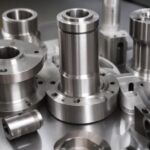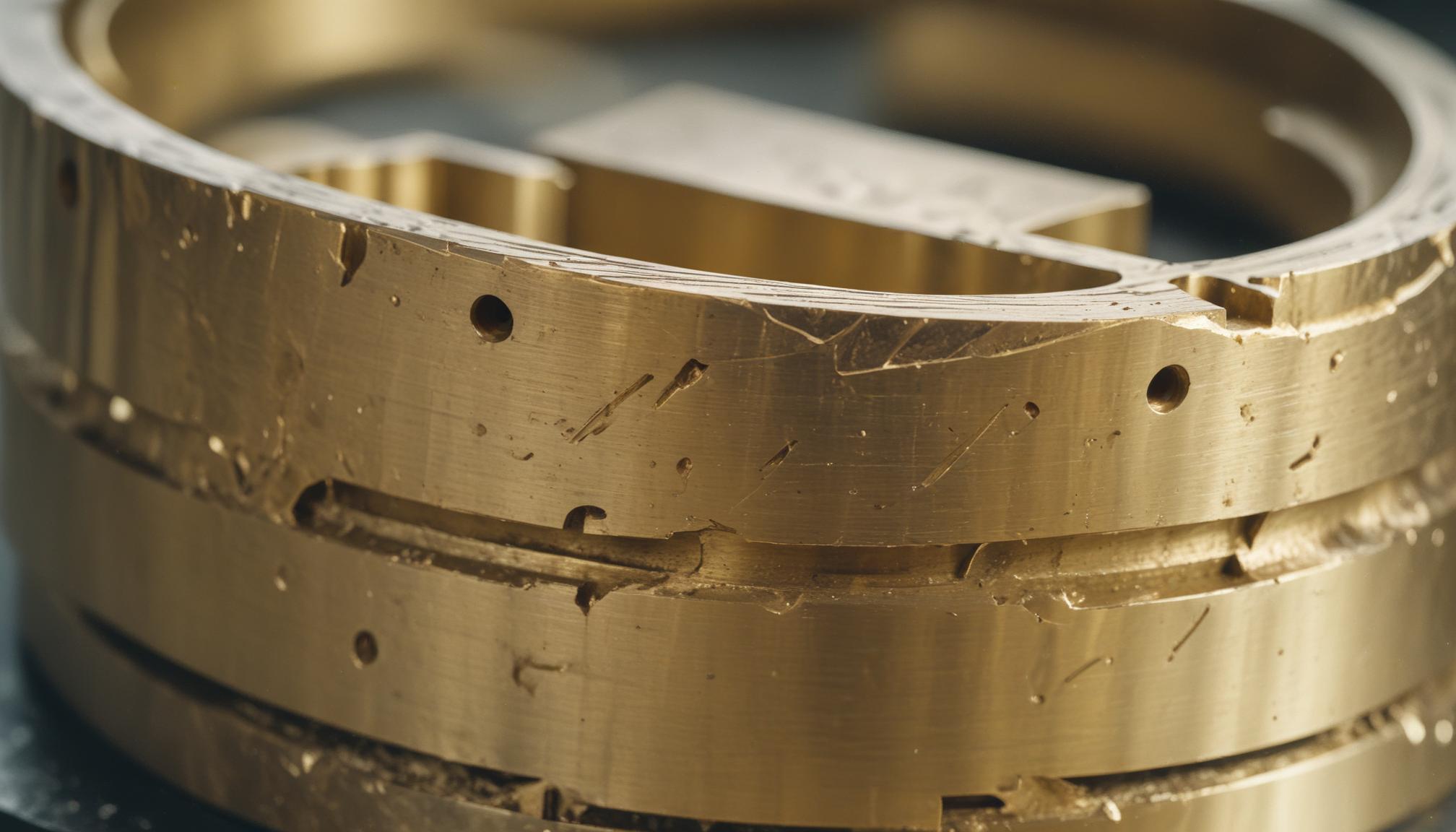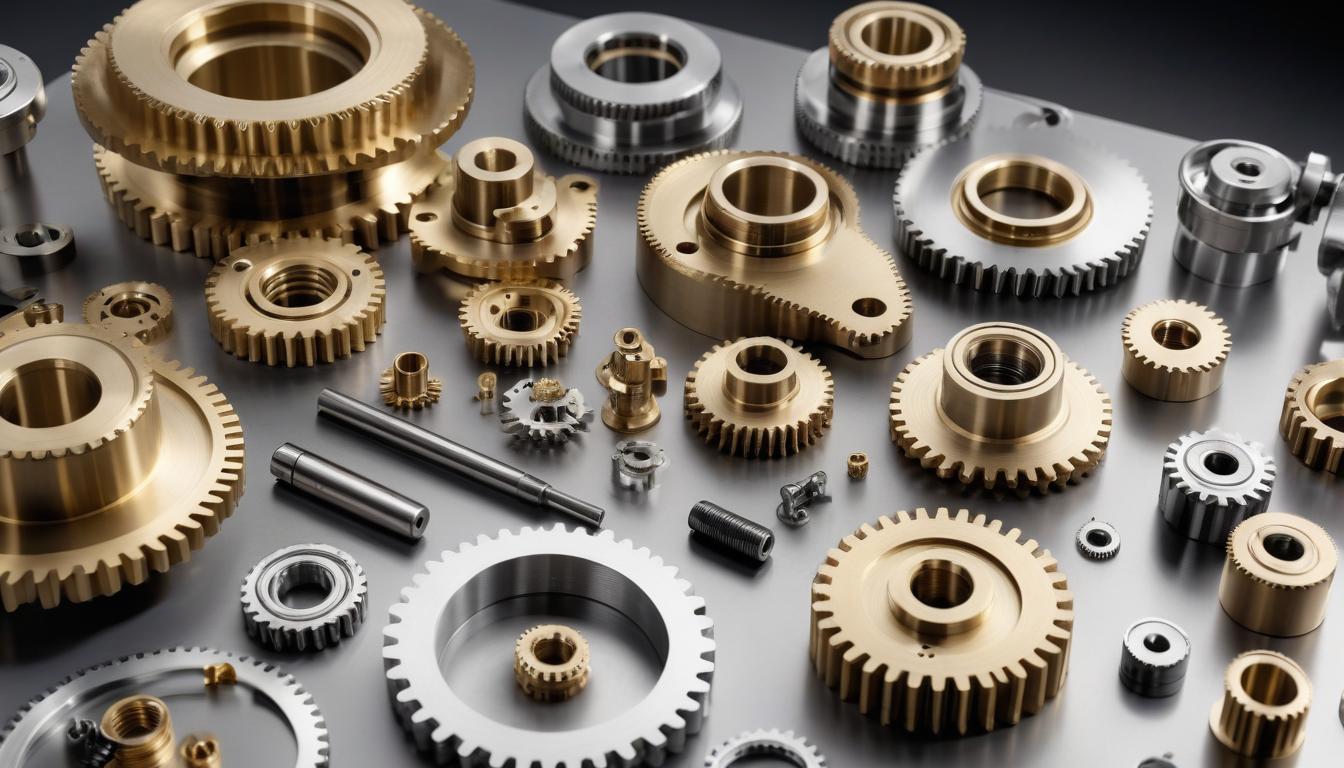
Everything You Need to Know About Turned Metal CNC Machining Services
9 August 2024
Barrel Milling Cutters Garner Attention Amidst Shifting Market Trends
15 August 2024Introduction
Brass, an alloy primarily composed of copper and zinc, has long been valued in various industries for its golden hue, excellent corrosion resistance, and superior machinability. Widely used in applications ranging from plumbing and electrical components to decorative pieces and musical instruments, brass is a material of choice for intricate, high-precision CNC machining. Its ability to be easily cut, shaped, and formed with minimal force or energy makes it ideal for producing detailed components. However, this very workability introduces unique challenges during the machining process that manufacturers must navigate to ensure quality and precision.
Understanding the complexities of brass CNC machining is essential for achieving optimal results. The machinability of brass can vary depending on factors such as its specific alloy composition, the tooling used, and the machining parameters set. These elements must be carefully balanced to avoid common issues like tool wear, chip control problems, and difficulties in maintaining tight tolerances. Despite brass’s favorable properties, addressing these challenges requires a deep knowledge of the material and the application of best practices specifically tailored to brass machining.
In this blog post, we will explore the common challenges in brass CNC machining and offer practical insights to overcome them. From managing tool wear and chip formation to optimizing cutting parameters and ensuring surface quality, this guide will provide valuable information for anyone looking to refine their brass machining processes. Whether you're new to working with brass or seeking to enhance your existing techniques, understanding these challenges and solutions will help you produce high-quality, precise parts with greater efficiency.
Material Properties of Brass
Brass, an alloy composed primarily of copper and zinc, boasts a unique combination of properties that make it highly suitable for a wide range of applications. The specific properties of brass can vary significantly depending on the exact composition and the presence of other alloying elements. This variability can present challenges during CNC machining, as different types of brass can behave differently under similar machining conditions.
Composition and Variability
Brass is not a single material but a family of alloys with varying compositions. The primary elements in brass are copper and zinc, but other elements such as lead, tin, aluminum, and iron can be added to impart specific properties. For instance, adding lead improves machinability, making leaded brass a popular choice for high-speed machining. However, the presence of lead can pose health and environmental concerns, requiring careful handling and disposal.
The zinc content in brass typically ranges from 5% to 45%, significantly impacting its properties. Higher zinc content generally increases the strength and hardness of the brass, while lower zinc content enhances its ductility and corrosion resistance. The variability in composition means that machinists need to understand the specific type of brass they are working with to optimize machining parameters effectively.
Machinability
One of the standout features of brass is its excellent machinability. Brass is relatively soft and easy to cut compared to many other metals, which means it requires less power and produces less tool wear. This makes brass an ideal material for high-speed machining and the production of intricate parts with fine details. The ease of machining also translates to shorter cycle times and lower production costs.
However, the machinability of brass can vary between different grades. For example, free-machining brass, which contains a small percentage of lead, offers exceptional machinability due to the lubricating effect of lead. On the other hand, more complex brass alloys, which may include elements like tin or aluminum, can present more significant challenges in terms of tool wear and chip control.
Mechanical Properties
The mechanical properties of brass, such as strength, ductility, and hardness, are crucial factors that influence the machining process. Brass is generally known for its excellent strength-to-weight ratio, making it suitable for applications where both durability and weight reduction are essential. The alloy's ductility allows it to be formed into various shapes without cracking, which is particularly beneficial in CNC machining, where complex geometries are often required.

Chip Formation and Control
Chip formation is a critical aspect of CNC machining that significantly impacts the efficiency, quality, and overall success of the machining process. In brass CNC machining, understanding how chips form and how to control them is essential for achieving high-quality results and maintaining optimal machine performance.
Chip Characteristics
The behavior of chips during the machining of brass can vary depending on the alloy's composition and the machining conditions. Typically, brass chips are characterized by their relative softness and malleability. When machining brass, you might encounter several types of chip formations:
- Continuous Chips: These are long, continuous strands of material that are often observed in free-machining brass. Continuous chips are generally easier to manage and remove but can sometimes lead to issues such as entanglement in the machine.
- Discontinuous Chips: These are short, segmented chips that break off more frequently. Discontinuous chips are common in harder brass alloys and can create more debris and potential machining issues, such as poor surface finish or increased tool wear.
- Stringy Chips: In some cases, particularly with certain brass alloys, chips can become stringy and difficult to manage. These stringy chips can wrap around the tool and workpiece, leading to potential problems with chip removal and surface quality.
Chip Evacuation
Effective chip evacuation is crucial for maintaining a clean machining environment and preventing issues such as chip buildup, which can affect tool performance and surface finish. Here are some strategies for managing chip evacuation in brass machining:
- Proper Tool Design: Tools with adequate chip grooves and flute designs can help direct chips away from the cutting area. Ensuring that the tool is designed to handle the specific type of chips produced by the brass alloy being used can improve chip removal efficiency.
- Optimized Cutting Parameters: Adjusting cutting parameters such as feed rate, cutting speed, and depth of cut can influence chip formation and evacuation. For example, higher cutting speeds can produce smaller, more manageable chips, while appropriate feed rates can help prevent chip clogging.
- Effective Coolant Use: Coolants and lubricants play a vital role in chip evacuation by reducing friction and heat, which can soften the chips and make them easier to remove. Proper coolant application helps in directing the chips away from the cutting area and maintaining tool performance.
- Chip Conveyors and Extraction Systems: Implementing chip conveyors and extraction systems in the machining setup can aid in the removal of chips from the work area. These systems help in maintaining a clean and efficient working environment by continuously transporting and collecting chips.

Surface Finish
The formation and control of chips directly impact the surface finish of the machined brass parts. Poor chip management can lead to issues such as:
- Surface Defects: Chips that are not effectively removed can lead to scratches, dents, and other surface imperfections. Ensuring proper chip evacuation helps in achieving a smooth and consistent surface finish.
- Tool Wear: Excessive or improper chip formation can contribute to increased tool wear, which in turn affects the surface quality of the machined parts. Regular monitoring and adjustment of machining parameters are necessary to minimize tool wear and maintain high-quality finishes.
- Heat Generation: Inadequate chip removal can result in increased heat generation at the cutting zone. Excessive heat can cause thermal damage to both the workpiece and the tool, leading to poor surface quality and reduced tool life.
Chip Control Strategies
To effectively control chip formation and maintain machining efficiency, consider the following strategies:
- Select the Right Tooling: Choose tooling materials and designs suited for the specific type of brass being machined. Tools with appropriate geometries and coatings can help manage chip formation and improve overall performance.
- Adjust Machining Parameters: Fine-tuning cutting speeds, feed rates, and depths of cut according to the brass alloy and machining conditions can help achieve optimal chip formation and evacuation.
- Implement Regular Maintenance: Regular maintenance of machining equipment, including tool sharpening and coolant system checks, ensures that the machining process remains efficient and chip control is maintained.
- Monitor and Adjust: Continuously monitor the machining process and make adjustments as needed to address any issues related to chip formation and control. This proactive approach helps in maintaining consistent quality and minimizing machining problems.
Cutting Parameters
Cutting parameters are crucial in CNC machining, directly influencing the efficiency, quality, and cost of the machining process. For brass, setting optimal cutting parameters ensures effective material removal, enhances tool life, and achieves desired part quality.
Speed and Feed Rates
- Cutting Speed: This refers to the speed at which the cutting tool engages the brass material. In brass machining, a higher cutting speed is generally preferred due to the material’s favorable machinability. However, excessive speeds can lead to increased heat generation and tool wear. It’s essential to balance speed with other parameters to avoid thermal damage.
- Feed Rate: The feed rate is the distance the tool advances into the material per revolution or per unit of time. A higher feed rate can increase productivity but may also lead to tool wear and reduced surface quality if not properly managed. For brass, moderate feed rates often provide the best results, ensuring a good balance between machining efficiency and surface finish.
Depth of Cut
The depth of cut refers to the thickness of the material removed in a single pass. For brass, depth of cut can significantly impact tool performance and part accuracy. Shallow cuts can improve surface finish and reduce tool wear, while deeper cuts increase material removal rates but require careful monitoring to prevent excessive tool load and potential deformation.
Coolant Use
Coolant application is vital in managing heat and friction during machining. Proper use of coolants and lubricants helps in:
- Reducing Heat: By cooling the cutting area, coolant minimizes thermal expansion and prevents overheating of both the tool and workpiece.
- Improving Chip Removal: Coolant helps in flushing chips away from the cutting zone, reducing the risk of chip re-cutting and ensuring a cleaner machining environment.
- Extending Tool Life: Effective cooling and lubrication reduce tool wear and increase its lifespan, leading to more consistent performance and reduced downtime.
Workholding and Fixturing
Effective workholding and fixturing are essential for ensuring precision, stability, and accuracy during CNC machining. Proper setup minimizes movement and vibration, which can affect part quality and machining efficiency.
Workpiece Stability
Ensuring that the brass workpiece is securely held in place is fundamental to achieving accurate and consistent results. Instability can lead to part distortion, reduced dimensional accuracy, and poor surface finish. Strategies for improving workpiece stability include:
- Clamping Systems: Use robust clamping systems to secure the workpiece. Vices, clamps, and chucks should be appropriately sized and positioned to ensure a firm grip without causing deformation.
- Vacuum Fixtures: For complex or delicate parts, vacuum fixtures can provide a strong, even hold without mechanical clamping, reducing the risk of deformation.
Fixturing Techniques
Selecting the right fixturing technique is crucial for maintaining part accuracy and repeatability. Common methods include:
- Custom Fixtures: Custom-designed fixtures tailored to specific parts can enhance stability and precision, especially for complex geometries.
- Modular Fixtures: Modular fixturing systems offer flexibility and adaptability, allowing for quick adjustments and changes between different parts or setups.
Vibration Control
Minimizing vibration during machining is crucial for achieving high precision and surface quality. Strategies for controlling vibration include:
- Machine Maintenance: Regular maintenance of the CNC machine, including checking for alignment and wear, helps in reducing vibrations.
- Rigid Setup: Ensure that all components, including tooling and fixtures, are securely mounted to minimize movement and vibration.
Dimensional Accuracy and Tolerances
Maintaining dimensional accuracy and adhering to tolerances are critical for ensuring that machined brass parts meet design specifications and function correctly.
Achieving Precision
- Machine Calibration: Regular calibration of CNC machines ensures that they operate within specified tolerances, maintaining precision across multiple parts.
- Tool Condition: Keeping cutting tools in optimal condition through regular maintenance and replacement helps in achieving consistent dimensional accuracy.
Thermal Expansion
Brass, like most metals, can expand or contract due to changes in temperature. Managing thermal expansion is essential for maintaining dimensional accuracy, especially in high-speed or high-temperature operations. Strategies include:
- Temperature Control: Maintaining a stable temperature in the machining environment helps in reducing thermal expansion effects.
- Toolpath Adjustments: Compensating for thermal expansion in the toolpath can help in achieving accurate dimensions despite temperature fluctuations.
Inspection and Measurement
Accurate inspection and measurement are vital for verifying that parts meet specified tolerances. Techniques include:
- Coordinate Measuring Machines (CMMs): CMMs provide high precision in measuring complex geometries and verifying dimensional accuracy.
- Gages and Micrometers: Standard measurement tools can be used for routine checks and ensuring parts meet tolerance requirements.

Surface Quality and Finish
The surface quality of machined brass parts impacts both their appearance and functionality. Achieving a high-quality finish requires attention to several factors during the machining process.
Surface Defects
Common surface defects include:
- Burrs: Small, rough edges or projections that can be removed through deburring processes.
- Scratches and Marks: Surface imperfections that can be minimized through careful handling and proper machining techniques.
Post-Machining Processes
To enhance surface quality, additional processes may be required:
- Deburring: Removing sharp edges and burrs using abrasive tools or processes.
- Polishing and Buffing: Achieving a smooth, shiny surface through mechanical polishing or chemical treatments.
Polishing and Buffing
Polishing and buffing are essential for achieving a high-quality finish on brass parts. Techniques include:
- Abrasive Polishing: Using abrasives to remove surface imperfections and achieve a smooth finish.
- Chemical Polishing: Applying chemical solutions to enhance the surface appearance and remove oxidation or tarnish.
Dealing with Complex Geometries
Machining complex geometries presents unique challenges, requiring advanced techniques and strategies to achieve precise results.
Design Considerations
- Complex Designs: Parts with intricate features require careful planning and design to ensure machinability and accuracy.
- Tool Access: Ensuring that tools can access all areas of the part without interference or limitations.
Tool Access
- Multi-Axis Machining: Utilizing multi-axis CNC machines allows for greater flexibility and precision in machining complex shapes and features.
- Specialized Tools: Employing specialized tooling for intricate features or tight tolerances can improve machining efficiency and accuracy.
Cost Considerations
Cost management is crucial for maintaining profitability in CNC machining operations. Factors affecting costs include:
Material Costs
- Brass Pricing: The cost of brass can vary depending on the alloy and market conditions. Choosing the right brass grade and managing material usage efficiently can help control costs.
Tooling Costs
- Tool Selection: High-quality tools may have higher upfront costs but can offer longer lifespans and better performance, leading to cost savings in the long run.
- Tool Wear and Replacement: Regular monitoring and timely replacement of worn tools prevent costly downtime and ensure consistent machining quality.
Production Efficiency
- Process Optimization: Optimizing machining parameters and workflows can increase efficiency and reduce production costs.
- Waste Management: Minimizing material waste through precise cutting and effective chip removal helps in controlling overall costs.

Safety and Environmental Considerations
Ensuring safety and environmental responsibility in CNC machining operations is essential for protecting workers and minimizing the ecological impact.
Health Risks
- Dust and Fumes: Brass machining can produce dust and fumes that may pose health risks. Implementing effective ventilation and protective measures helps in safeguarding worker health.
- Protective Gear: Providing appropriate personal protective equipment (PPE) such as safety goggles, gloves, and masks reduces exposure to potential hazards.
Waste Management
- Chip Disposal: Proper disposal and recycling of brass chips and scrap material help in reducing environmental impact and promoting sustainability.
- Chemical Management: Managing and disposing of machining chemicals and coolants in accordance with regulations prevents environmental contamination.
Environmental Impact
- Energy Efficiency: Implementing energy-efficient practices and technologies helps in reducing the overall environmental footprint of machining operations.
- Sustainable Practices: Adopting sustainable practices, such as recycling and reducing waste, contributes to environmental responsibility and conservation.
Conclusion
Brass CNC machining presents a range of challenges that, when understood and addressed effectively, can lead to high-quality, precise, and efficient manufacturing outcomes. From managing the unique properties of brass and optimizing cutting parameters to ensuring proper chip control and achieving excellent surface finishes, every aspect of the machining process must be carefully calibrated. By implementing best practices for tool selection, workholding, and dimensional accuracy, machinists can overcome common obstacles and produce components that meet stringent standards.
As with any manufacturing process, ongoing attention to safety and environmental considerations is crucial. Ensuring worker health and minimizing the environmental impact through proper waste management and sustainable practices not only enhances operational efficiency but also aligns with broader industry standards and regulations. Mastering these elements of brass CNC machining will not only improve production quality but also contribute to a more responsible and effective machining operation.




